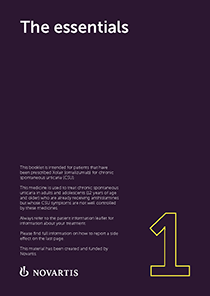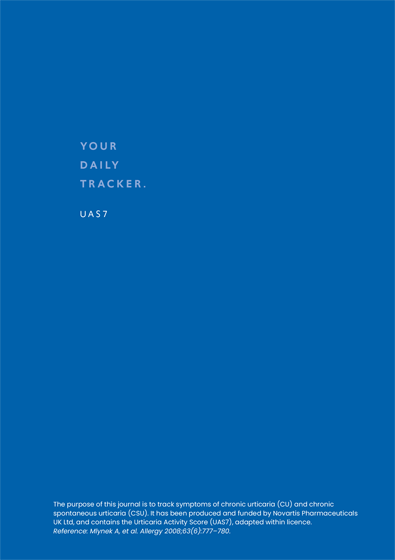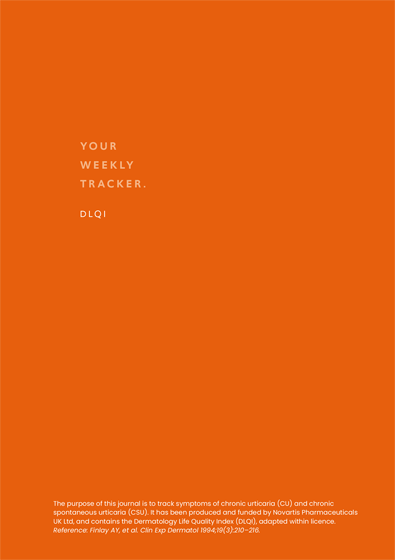

This page is specifically intended to support patients who have been prescribed Xolair® (omalizumab) for chronic spontaneous urticaria by their Great Britain healthcare provider. If you have any questions about your medication, ask your doctor, nurse or pharmacist and read the patient information leaflet (PIL) provided with your medicine.
These resources do not replace the PIL that comes with your medication. The PIL contains additional important information on the use of this medicine that is not fully covered in these resources. Always read the PIL for full information.
Patient resources
Below you will find a range of resources developed to help you manage your chronic spontaneous urticaria (CSU) and use Xolair. These resources provide information on injecting Xolair at home once your doctor or nurse has determined that is it appropriate for you to do so, as well as guidance on how to track changes in your symptoms. If you require any further information or are concerned about any aspect of the injection, talk to your healthcare professional.

Self-administration starter kit (1): The essentials
This booklet has been designed to give you more information about what chronic spontaneous urticaria is and how it is diagnosed and treated. You will also find details explaining what you can expect from treatment with Xolair.

Self-administration starter kit (2): A guide to self injection
This booklet provides you with a step-by-step guide on how to self-inject Xolair. You will also find information on how to store and safely dispose of your injection syringe and autoinjector pen.

Self-administration starter kit (3): Things for you to fill in
This booklet provides a space for you to keep track of your symptoms, which your doctor or nurse will check to see if Xolair is working for you. The tracker includes three different tests that all monitor different aspects of your CSU.

Self-administration starter kit (4): Important information
Within this booklet you can find safety information regarding possible symptoms of allergic reactions (including anaphylaxis) when using Xolair.1 You will also find details on the steps you need to take if allergic reactions occur.

Your daily tracker
This booklet contains a weekly Urticaria Activity Score (UAS7) calculator, which measures the number of hives and the severity of itch you experience daily. It is a designated booklet for you to use to keep track of the symptoms you experience day by day.

Your weekly tracker
This booklet contains a weekly tracker that focuses on your Dermatology Life Quality Index (DLQI), helping you assess how your urticaria affects the quality of your day-to-day life, each week.

Your monthly tracker
This booklet contains a monthly Urticaria Control Test (UCT), which will help you assess how well controlled your urticaria is over a four-week period. It can be completed by answering just four simple questions.
A short video to support you to inject your Xolair at home, once you’ve been trained by your healthcare provider. You can read more about Xolair and how to use it in the patient information leaflet (PIL). This link will take you to the electronic medicines compendium (emc) website, which is a non-Novartis website.*
Use this video to learn how to prepare and use the Xolair autoinjector at home, once you or your caregiver have been trained by your healthcare provider. You can read more about Xolair and how to use it in the patient information leaflet (PIL). This link will take you to the electronic medicines compendium (emc) website, which is a non-Novartis website.*
*The PIL is the leaflet included in the pack with a medicine. It is written for patients and gives information about taking or using a medicine. It is possible that the leaflet in your medicine pack may differ from this version because it may have been updated since your medicine was packaged.
Reference
Xolair® (omalizumab) Patient Information Leaflet.
UK | October 2024 | FA-11222322
Reporting side-effects
If you get side-effects with any medication you are taking, talk to your doctor, pharmacist or nurse. This includes any possible side-effects not listed in the information leaflet that comes in the pack. You can report side-effects via the Yellow Card Scheme at www.mhra.gov.uk/yellowcard.
By reporting side-effects you can help provide more information on the safety of your medication.

